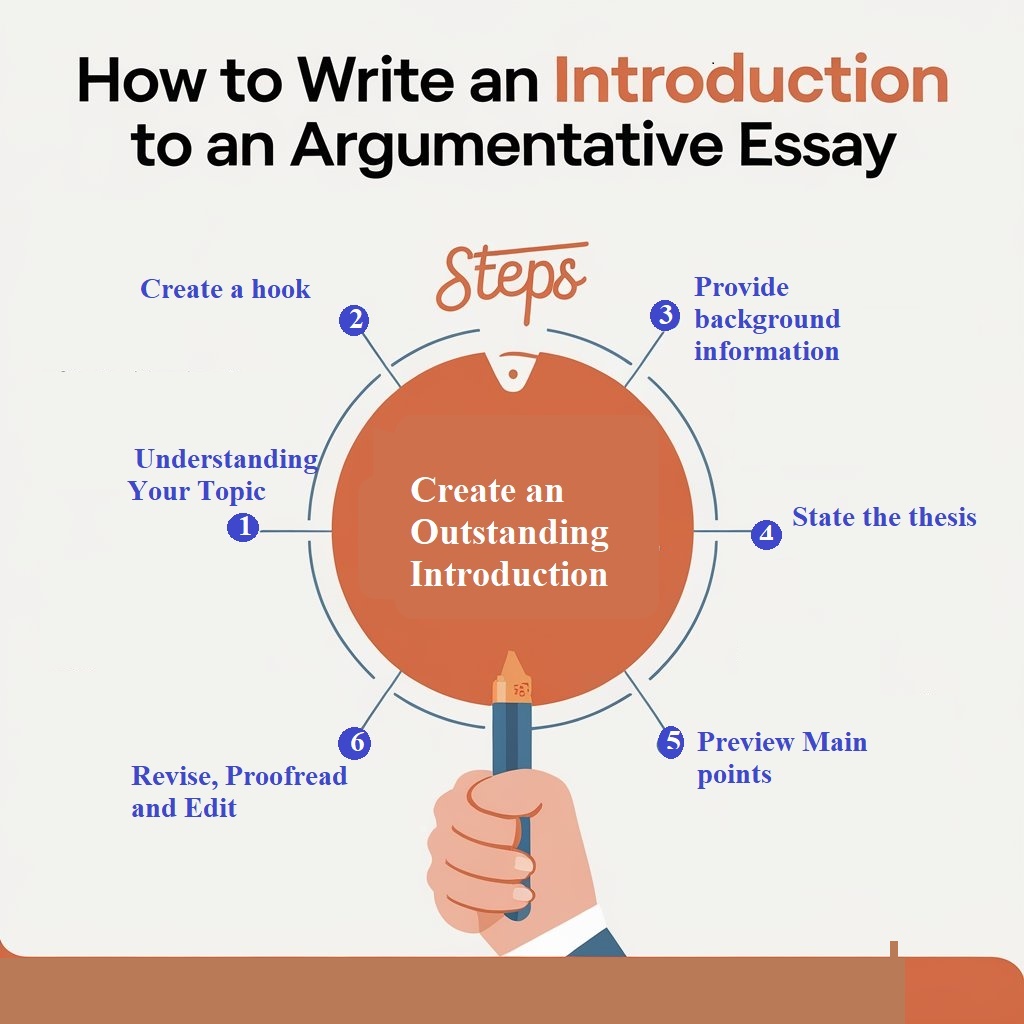An argumentative essay introduction is your chance to grab the reader’s attention, provide background on the topic, and clearly state your position. A strong introduction starts with a compelling hook, such as a thought-provoking question, a striking fact, or a bold statement, followed by context that helps the reader understand the issue.
It should then lead smoothly into a concise thesis statement outlining your main argument. Your introduction establishes the foundation for a persuasive and well-structured essay by setting the stage effectively.
Why Is the Introduction Important in an Argumentative Essay?
The introduction of an argumentative essay is crucial because it sets the stage for the entire argument, capturing the reader’s attention and establishing the essay’s purpose. This is why a substantial introduction matters,
- Grabs Attention
A compelling introduction piques readers’ interest with a hook, such as a question, statistic, or bold statement, making them eager to continue reading.
- Provides Background Information
It offers context, helping readers understand the issue before diving into the argument.
- Establishes the Relevance of the Topic
The introduction explains why the topic is essential, showing its significance in academic, social, or political contexts.
- Introduces the Thesis Statement
The thesis is the central claim of the essay. A well-written thesis statement presents the main argument concisely, guiding the reader on what to expect.
- Outlines the Argument Structure
A brief overview of the main points ensures a logical flow, preparing the reader for the discussion.
A strong introduction makes an argumentative essay more persuasive and engaging. A weak introduction, however, can confuse readers, cause them to fail to set up the argument correctly or cause them to lose interest altogether.

What Makes a Good Argumentative Essay Introduction?
A good argumentative essay introduction is engaging and sets the foundation for a strong argument. Lets go through the key elements that make it effective,
1. A Strong Hook
Start with an attention-grabbing statement that intrigues the reader. This could be:
- A shocking statistic
- A thought-provoking question
- A bold claim or statement
- A brief anecdote
Example
According to a 2023 survey by BestColleges, 50% of college students admitted to using AI-powered tools like ChatGPT for academic work. This raises an important question: Is technology enhancing education or enabling academic dishonesty?
2. Background Information
Provide context about the topic so readers understand the issue. This should be brief but informative, highlighting key facts or debates.
Example
With the rise of AI-powered tools, educators and students face a new challenge: balancing technological innovation with academic integrity. While some argue that AI aids learning, others worry it fosters dependency and weakens critical thinking.
3. A Clear Thesis Statement
The thesis statement is the most essential part of the introduction. It presents your main argument and sets the direction for the essay. It should be specific, debatable, and straightforward.
Example
While AI tools can enhance learning, their unregulated use in academia promotes dependency and weakens critical thinking skills, making it essential for institutions to establish ethical guidelines.
4. A Preview of the Main Arguments
Briefly mention the key points you will discuss in the essay. This helps guide the reader and improve the flow.
Example
This essay will explore how AI impacts education, its potential risks, and why a balanced approach is necessary to ensure academic integrity.
Common Mistakes to Avoid in an Argumentative Essay Introduction
Even well-intentioned writers sometimes make mistakes in their introductions. Here are a few pitfalls to avoid:
Instead of saying, “Technology is changing education,” specify how it is changing education.
- Starting with a Definition
Avoid dictionary definitions; instead, provide engaging context or a compelling fact.
A weak thesis leaves the reader confused about your argument. Make sure your position is explicit.
- Not Relating the Topic to the Audience
Show why the issue matters in a broader academic, social, or political context.
Dos and Don’ts of Writing an Introduction for an Argumentative Essay
A substantial introduction sets the tone for the entire essay. Here’s what you should do and avoid when writing it.
Dos
1. Start with a Hook
Grab the reader’s attention with a shocking fact, question, quote, or bold statement.
Example:
Did you know that social media addiction affects over 210 million people worldwide?
2. Provide Background Information
- Give brief context to help the reader understand the issue.
- Define key terms if necessary.
3. State a Clear Thesis Statement
- Present your main argument clearly and concisely.
Example:
Social media has more negative than positive effects on mental health, leading to anxiety, depression, and reduced self-esteem.
4. Keep It Concise and Relevant
- Stick to the key points; don’t overwhelm the reader with too much information upfront.
5. Maintain a Neutral and Professional Tone
- Even if you’re passionate, avoid emotional or biased language.
Don’ts
1. Don’t Start with a Generic Statement
Avoid broad or obvious openings like:
Example:
“Since the beginning of time, people have argued about technology.”
2. Don’t Include Too Many Details
- Keep historical data, case studies, and lengthy explanations for the body paragraphs.
3. Don’t Use Weak or Unclear Thesis Statements
Avoid vague arguments like:
Example:
“There are good and bad sides to social media.”
Instead, take a clear stance.
4. Don’t Use First-Person (“I think,” “In my opinion”)
- Argumentative essays should be formal and objective.
5. Don’t Apologize or Sound Uncertain
Avoid phrases like:
Example:
“This may not be the best argument, but…”
Be confident in your position.
introduction argumentative essay examples
Social media has transformed the way we communicate, but at what cost? Studies show that excessive social media use is linked to rising levels of anxiety and depression, particularly among teenagers. While some argue that these platforms promote connection, the adverse psychological effects outweigh the benefits. This essay will argue that social media contributes to mental health issues by fostering unrealistic comparisons, cyberbullying, and addictive behaviors.
How to Write an Argumentative Essay Introduction
A substantial introduction sets the foundation for a compelling argumentative essay. Follow these steps to write an engaging and practical introduction.
1. Start with a Hook
Grab your reader’s attention with an interesting opening. This could be:
- A thought-provoking question →: Should social media platforms be held accountable for misinformation?
- A shocking statistic →: Over 3.6 billion people use social media daily, yet studies show it contributes to rising anxiety levels.
- A bold statement →: The death penalty is an outdated and unethical form of punishment that should be abolished.
The hook should be relevant to your topic and make the reader curious to keep reading.
2. Provide Background Information
Before diving into your argument, provide brief context. This helps readers understand the issue.
- Define key terms if necessary.
- Explain the controversy or debate surrounding the topic.
- Keep it short and relevant—avoid giving too much detail.
Example:
Social media has revolutionized the way we connect and share information. However, its role in spreading misinformation and increasing mental health concerns has sparked global debates.
3. State Your Thesis Clearly
The thesis statement is the heart of your introduction—it presents your main argument in one sentence. It should be:
- Clear and specific
- Debatable (not just stating a fact)
- Concise
Example:
While social media enhances global communication, it also fuels misinformation and mental health crises, making it essential for stricter regulations to be implemented.
4. Briefly Outline Your Main Points
A roadmap can help guide the reader by mentioning the main arguments you’ll discuss in the essay.
Example:
This essay will examine the harmful effects of social media on mental health, its role in misinformation, and why stronger regulations are necessary.
Argumentative Essay Introduction Outline
A well-structured introduction sets the stage for a strong argumentative essay. Follow this outline to ensure clarity and engagement.
1. Hook (Attention-Grabbing Statement)
Start with a compelling opening that grabs the reader’s attention. Choose one of these approaches:
- A shocking statistic →: Over 1.3 million people die in road accidents annually, yet some argue against stricter driving laws.
- A thought-provoking question →: Should college education be free for all students?
- A bold statement →: Artificial intelligence will replace millions of jobs in the next decade.
- A short anecdote → Emma, a bright student, dropped out of college because of crippling tuition fees. Her story is not unique.
Ensure your hook is relevant to your topic.
2. Background Information (Context)
Provide brief context so the reader understands the issue. This may include:
- A brief explanation of the topic
- Key terms or definitions (if necessary)
- The debate or controversy surrounding the issue
Example:
Social media plays a crucial role in communication in today’s digital world. However, many experts argue that it contributes to misinformation and declining mental health.
Keep this section concise—save the deeper analysis for the body paragraphs.
3. Thesis Statement (Your Main Argument)
This is the most crucial sentence in your introduction. It should:
- Clearly state your position
- Be specific and debatable
- Set the direction of your essay
Example:
While social media connects people globally, its adverse effects on mental health and the spread of misinformation make it necessary for stricter regulations.
Avoid vague or neutral statements and take a clear stance.
4. (Optional) Essay Roadmap
Provide a brief preview of your main points to guide the reader.
Example:
This essay will explore how social media impacts mental health, its role in spreading misinformation, and why regulation is essential.
How to write an evaluation essay
Final Thought
A strong introduction is the foundation of a compelling argumentative essay, as it grabs the reader’s attention, provides essential background information, and presents a clear thesis statement. A practical introduction starts with a hook, a thought-provoking question, a statistic, or a bold statement to engage the audience.
It then offers context to help readers understand the topic before leading into a concise, debatable thesis outlining the main argument. By mastering these elements, writers can create introductions that set the stage for persuasive and well-structured essays, ensuring clarity, engagement, and a strong start to their argument.









 Evan John
Evan John